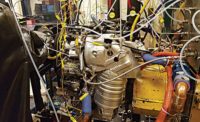Assembly Lines
New Aluminum Alloy Is Ideal for Additive Manufacturing

A patent-pending method creates ultra high-strength aluminum alloys that also demonstrate high plastic deformability.
Photo courtesy Purdue University
WEST LAFAYETTE, IN—Engineers at Purdue University have developed a high-strength aluminum alloy that is ideal for additive manufacturing applications because of its plastic deformability. The innovation has practical applications in a variety of industries, including aerospace and automotive manufacturing.
“Most commercially available high-strength aluminum alloys cannot be used in additive manufacturing,” claims Xinghang Zhang, Ph.D., a professor of material engineering at Purdue University. “They are highly susceptible to hot cracking, which creates defects that could lead to the deterioration of a metal alloy.”
A traditional method to alleviate hot cracking during additive manufacturing is the introduction of particles that strengthen aluminum alloys by impeding the movements of dislocations.
“But, the highest strength these alloys achieve is in the range of 300 to 500 megapascals, which is much lower than what steels can achieve, typically 600 to 1,000 megapascals,” says Zhang. “There has been limited success in producing high-strength aluminum alloys that also display beneficial large plastic deformability.”
Zhang and his colleagues have produced new aluminum alloys by using several transition metals including cobalt, iron, nickel and titanium. These materials have traditionally been avoided in the manufacture of aluminum alloys.
“These intermetallics have crystal structures with low symmetry and are known to be brittle at room temperature,” explains Zhang. “But, our method forms the transitional metal elements into colonies of nanoscale, intermetallic lamellae that aggregate into fine rosettes. The nanolaminated rosettes can largely suppress the brittle nature of intermetallics.
“Our work shows that the proper introduction of heterogenous microstructures and nanoscale medium-entropy intermetallics offers an alternative solution to design ultra-strong, deformable aluminum alloys via additive manufacturing,” says Zhang. “These alloys improve upon traditional ones that are either ultra strong or highly deformable, but not both.
“The heterogeneous microstructures contain hard nanoscale intermetallics and a coarse-grain aluminum matrix, which induces significant back stress that can improve the work hardening ability of metallic materials,” Zhang point out. “Additive manufacturing using a laser can enable rapid melting and quenching, and thus introduce nanoscale intermetallics and their nanolaminates.”Looking for a reprint of this article?
From high-res PDFs to custom plaques, order your copy today!






